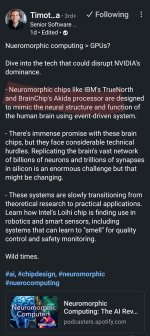So many good articles out there at the mo from all sort of publications from various diff countries espousing the Pico advancements. This is one I quite liked.
Given Pico would have been in Dev for some time, possibly in conjunction or at the behest of a partner (or NDA) and now fully capable prior to the recent BRN release, why do I get the feeling that there might just be something more tangible in the wings.
C'mon BRN
 View attachment 70425
View attachment 70425
BrainChip, an edge artificial intelligence (AI) specialist, has recently unveiled an innovative addition to its Akida family called the Akida Pico. This neuromorphic processor is being celebrated as the “lowest power acceleration.

developmentcurated.com
Home /
AI & Trends / How Will BrainChip’s Akida Pico Revolutionize Wearable AI Tech?
How Will BrainChip’s Akida Pico Revolutionize Wearable AI Tech?
October 2, 2024
Image credit: Unsplash
 Russell Fairweather
Russell Fairweather
BrainChip, an edge artificial intelligence (AI) specialist, has recently unveiled an innovative addition to its Akida family called the Akida Pico. This neuromorphic processor is being celebrated as the “lowest power acceleration coprocessor” ever produced, specifically geared towards wearable technology and sensor-integrated markets. Offering immense promise for the future of AI-driven applications, the Akida Pico pushes the boundaries of power efficiency and compactness. In a world where wearable devices and smart technology are increasingly ubiquitous, BrainChip’s latest offering could represent a significant leap forward in both design and functionality.
The Akida Pico is engineered to meet the burgeoning needs of the next generation of wearable devices. As consumers continue to demand more efficiency and compact designs from their technology, this processor promises to deliver on both fronts. Built on the second-generation Akida2 platform, Akida Pico is crafted to be exceptionally power-efficient and compact, making it an ideal candidate for integration in various high-efficiency systems. This advancement is a testament to BrainChip’s ongoing commitment to innovation and its strategic vision for the future of artificial intelligence.
Technological Breakthroughs in Akida Pico
The second-generation Akida2 platform, upon which the Akida Pico is built, takes inspiration from the architecture of the human brain for its neuromorphic processing capabilities. This neuromorphic design enables the processor to handle machine learning (ML) and artificial intelligence (AI) workloads with remarkable efficiency.
One of the standout features of the Akida Pico is its ultra-low power consumption, drawing under 1 milliwatt (mW) even when under load. In addition to low power draw, the chip’s power island design ensures an extremely low standby power requirement, making it a highly efficient option for battery-operated devices.
Compactness and efficiency are at the core of the Akida Pico’s design philosophy. The chip is engineered to take up minimal physical space, aligning it perfectly with the trend towards smaller and more efficient electronic components. This makes it an ideal choice for integration into wearable devices, environmental sensors, and even smart home technologies. By providing continuous AI operations in such compact form factors, the Akida Pico facilitates a significant increase in efficiency for always-on systems. In effect, it supports the seamless operation of devices requiring continuous data collection and processing without compromising on power consumption or physical space.
A Paradigm Shift in Wearable Technology
The Akida Pico ushers in a new era for wearable technology, particularly in battery-powered devices where efficiency and longevity are paramount. One of the chip’s standout functionalities is its ability to serve as a wake-up trigger for more powerful microcontrollers or application processors upon detecting specific conditions. This feature is particularly advantageous for fitness trackers, health-monitoring systems, and environmental sensors—devices that require constant data collection and processing. By acting as an intelligent gatekeeper, the Akida Pico ensures that larger, more power-intensive components only activate when necessary, conserving battery life and enhancing device functionality.
The shift towards always-on AI operations facilitated by the Akida Pico promises to revolutionize the way wearables interact with users. These devices can now maintain continuous interaction without frequent battery charges, delivering smarter and more engaging user experiences. By incorporating the Akida Pico as a wake-up gatekeeper, wearable devices can offer enhanced functionality while conserving energy. This balance of power efficiency and performance can significantly extend the lifecycle of wearables, making them more reliable and user-friendly. Consequently, consumers stand to gain immensely from longer-lasting, more efficient devices, propelling wearable tech into a new realm of possibilities.
Bridging the Gap with MetaTF Software
On the software side, BrainChip enhances the Akida Pico’s versatility through its proprietary MetaTF software. This development platform supports the compilation and optimization of Temporal-Enabled Neural Networks (TENNs), allowing developers to seamlessly import and optimize models crafted in popular frameworks like TensorFlow, Keras, and PyTorch. This capability mitigates the need for developers to learn new frameworks, streamlining the AI deployment process. The ease of integrating pre-existing models into the Akida Pico environment is a significant advantage, as it accelerates the development cycle and ensures that innovative AI solutions are brought to market faster.
MetaTF software not only makes the development process smoother but also brings a user-friendly interface to the table, promoting efficiency in model deployment. This software ecosystem ensures that developers can quickly adapt and iterate their AI models to leverage the ultra-low power and compact features of the Akida Pico. The ability to rapidly deploy and optimize models is crucial for creating scalable AI solutions that meet a variety of application requirements. By bridging the gap between cutting-edge technology and practical application, MetaTF empowers developers to maximize the potential of neuromorphic computing in real-world scenarios.
Strategic Approach and Market Positioning
BrainChip’s decision to release the Akida Pico as Intellectual Property (IP) rather than standalone hardware represents a strategic and forward-thinking move. This approach allows other manufacturers to integrate the Akida Pico into their chip designs, fostering widespread adoption across multiple industries. By positioning the Akida Pico as an easily integrable IP, BrainChip is poised to become a central player in the semiconductor and edge AI development ecosystems. This move not only promotes greater industry collaboration but also accelerates the adoption of advanced AI technologies across a broad spectrum of applications.
Although BrainChip has not yet disclosed the exact pricing details for the Akida Pico IP, the company assures that further information is available on their official website. This strategic direction underscores BrainChip’s role as a pioneer in the AI on-chip solutions market. By making advanced, power-efficient AI technologies more accessible, BrainChip aims to drive innovation and set new industry standards. The release of the Akida Pico as an IP highlights BrainChip’s commitment to providing versatile and efficient AI solutions, positioning the company at the forefront of technological advancements in the edge AI space.
Key Innovations and Emerging Trends
BrainChip, a leader in edge artificial intelligence (AI), has introduced a groundbreaking addition to its Akida lineup: the Akida Pico. Heralded as the “lowest power acceleration coprocessor” ever developed, the Akida Pico is purpose-built for wearable tech and sensor-rich markets. This neuromorphic processor promises a future brimming with AI-driven applications by extending the limits of power efficiency and compact design. In an era where wearables and smart devices are becoming indispensable, BrainChip’s new innovation signifies a major step forward in both technology and functionality.
The Akida Pico is designed to satisfy the growing demands of next-generation wearable devices. As consumers seek more efficient and compact technological solutions, this processor aims to meet those expectations. Originating from the second-generation Akida2 platform, the Akida Pico combines exceptional power efficiency with a compact form, making it ideal for diverse high-efficiency systems. This development underscores
BrainChip’s unwavering dedication to innovation and its strategic foresight, setting new benchmarks for the future of artificial intelligence








